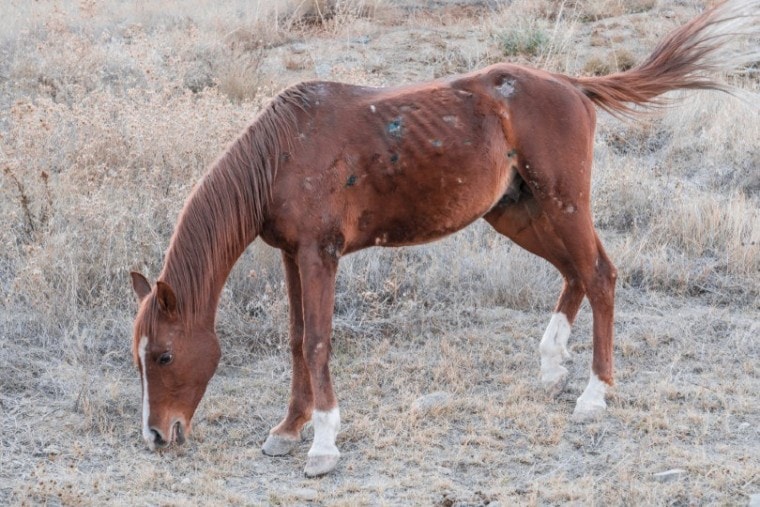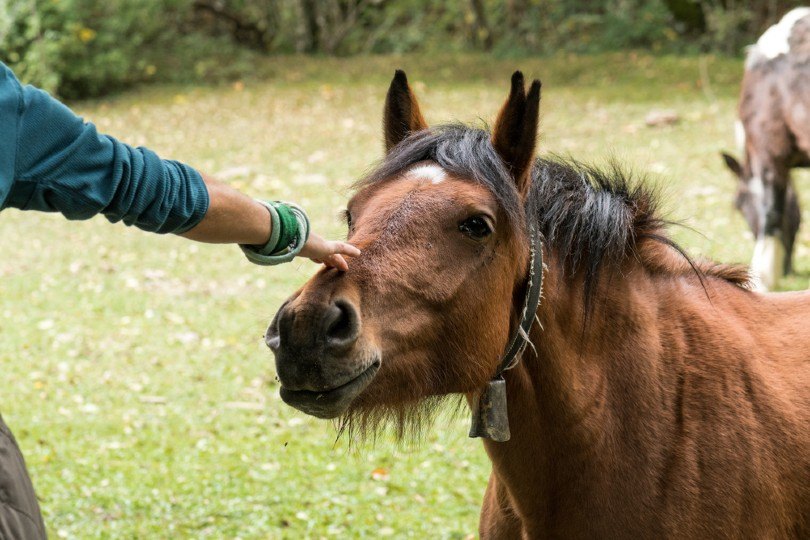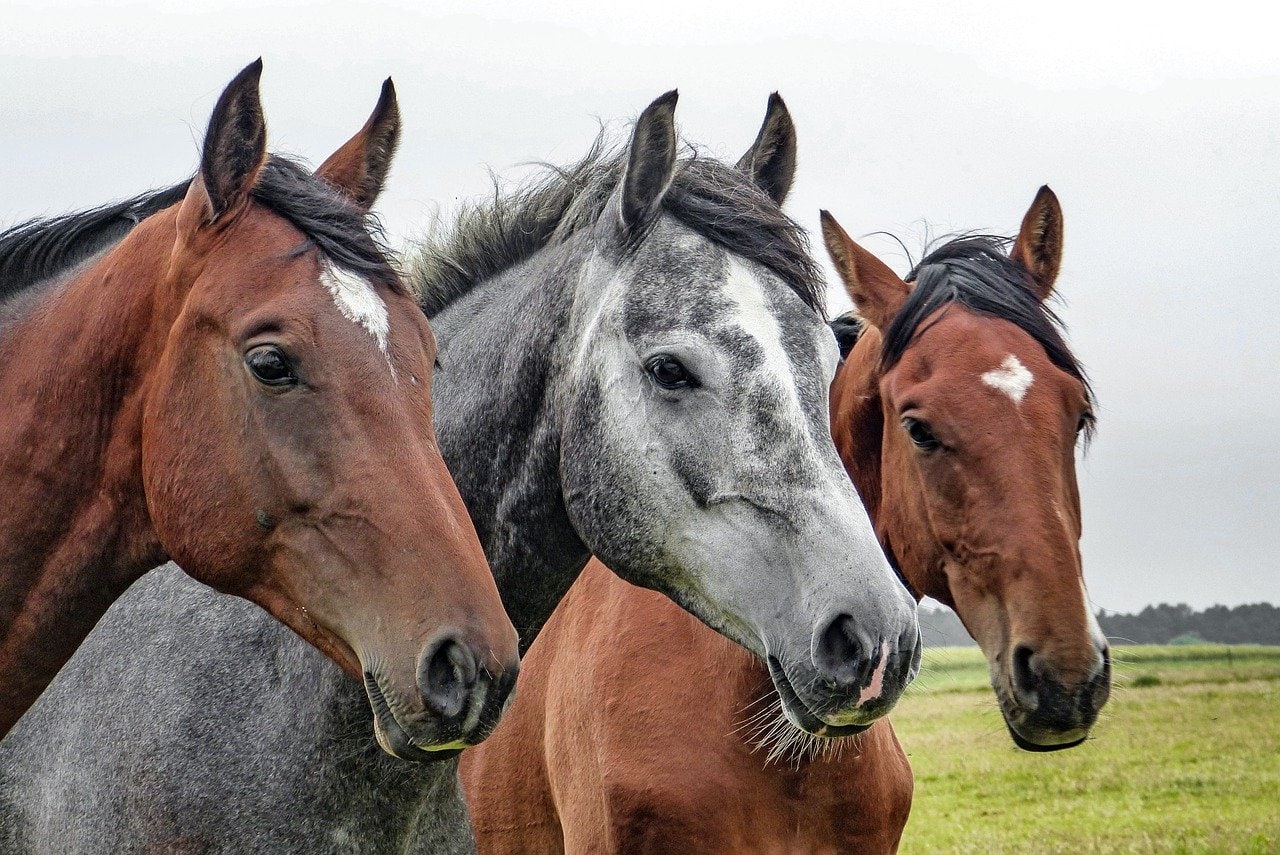
If you’ve been around horses long enough, you’ve almost certainly heard of rain rot. It’s one of the most common skin infections that affect horses, though it’s often mistaken for a fungal disease. It’s easily identifiable by the scabs that appear in the affected area, and luckily, it’s a pretty easy to cure condition.
In this article, we’re going to cover a wide range of topics regarding this infection, including how to prevent it from affecting your horses and even how to treat it should infection occur.
What Is Rain Rot?
You may have heard rain rot called by other names, such as rain scald or dermatophilosis. This condition is caused by an infection of the organism Dermatophilus congolensis. Often mistaken for a fungus, this organism is actually a gram positive bacterium.
This bacterium creates scabs in the infected areas, causing hair to be lost in small tufts. The condition isn’t considered an immediate medical emergency. However, depending on where the scabs form, the disease can be irritating for your horse.
Horses with severe generalized infections often lose condition, and movement is difficult if the hooves, lips, and muzzle are severely affected. In such instances, the condition is very painful, and severely infected horses may have to be euthanized.

How Does Rain Rot Occur?
The Dermatophilus congolensis bacterium is the main culprit of rain rot, but it doesn’t cause problems in all conditions. This infection is called rain rot because it requires a warm, moist environment to multiply and take hold. These bacteria are usually present in the environment, but they don’t generally affect the horse until the skin becomes compromised.
This can occur through several means. If your horse is wet for a long period, that can be the catalyst necessary to allow rain rot to take hold. Other things that can compromise your horse’s skin include excessive humidity, high temperatures, and even insect bites. Younger horses seem to be more susceptible than older horses.
Regional Rain Rot
Because rain rot is so environmentally dependent, it’s far more common in certain locales. Some regions rarely see rain rot, such as arid desert regions in the southwestern portion of the United States. More humid places that see higher amounts of rainfall will see far more cases of rain rot. This includes places like Florida and any coastal states where humidity is often high and rain is a regular occurrence.
How to Identify Rain Rot
The hallmark of rain rot is the scabs that appear when infection occurs. But this isn’t the only clue to aid in your diagnosis. Furthermore, scabs can also be present with other skin infections, so your diagnosis isn’t guaranteed to be accurate.
Horses with long winter coats won’t develop scabs the same as horses with shorter summer coats. Instead of seeing large scabs, you’re more likely to notice matted tufts of raised hair that are referred to as paintbrush lesions. These lesions will grow and multiply with time, eventually forming one large scab with visible pus excretions between the dead and living layers of skin.
The most surefire way to diagnose rain rot is to examine a scraping of the skin under a microscope. Alternatively, you could culture the bacteria. These methods can practically guarantee an accurate diagnosis, though you’ll probably have to have a vet perform the procedure. If your vet has trained you on how to collect a sterile skin sample from your horse, you can send a sample of their skin swab to a laboratory for identification; however, it is still best to have your veterinarian come over and inspect your horse. At times, rain rot can be secondary to other underlying health issues.

Will It Heal Naturally?
For many people, when a health concern arises, the natural inclination is to see if it works itself out. When it comes to rain rot, this isn’t a healthy approach to take. Instead, you’re far better off nipping it in the bud and taking action the second you notice an infection starting to set in.
That said, some horses can naturally rid themselves of this infection. Generally speaking, the onset of dry weather speeds the healing process. Care should be taken not to let anything rub against the scabs, such as a saddle.
Consequences of Rain Rot
There’s a good reason why you should treat rain rot immediately. Even though some horses can cure it with the shedding of their winter coat, if the infection isn’t cleared up quickly, it can lead to even worse problems.
Rain rot needs a hot, moist environment to survive. These conditions also happen to be a breeding ground for other bacteria, which is why secondary infection is so common when dealing with rain rot. At times, these infections can be more dangerous and even harder to treat than rain rot.
Spreading the Infection
One of the more interesting aspects about rain rot is how it spreads. Since it’s caused by an organism, if that organism is transferred to another horse, that horse may also end up with rain rot if their skin barrier is compromised. This means that any shared equipment between horses is practically guaranteed to cause multiple infections.
If a horse has rain rot, you’ll need to ensure that no other horses come in contact with any equipment used on the infected horse, including saddles, saddle pads, leg wraps, brushes, halters, and any other piece of tack. It’s recommended that you thoroughly disinfect each piece of equipment immediately after an infected horse uses it.
Insects can even spread rain rot from horse to horse. They bite one horse, then fly over to bother another, transferring the infection along with them. So, even if you do your best to avoid cross-contamination, the insects might cause it anyway.
Rain rot can be transmitted to people. Direct contact with an infected horse can lead to infections on your hands and arms. A horse with rain rot should be handled with gloves, and thorough handwashing with an antibacterial soap is recommended after contact with the horse.

Curing Rain Rot
Treatment involves appropriate antibiotics. The scabs on your horse are painful and already require treatment; they should be gently soaked and removed. Your veterinarian can provide instructions for this.
Topical antibacterial shampoo treatment is often effective and may be prescribed along with other medications. If your horse has a long coat, your vet may advise you to clip their coat. Successful treatment also requires removing the horse from the damp or wet environment that triggered the infection.
Infected horses should be isolated from other animals to reduce spread of the disease. Careful attention should given to the cleanliness of the following areas and items:
Insect controls are often recommended for the same reason because insects can carry the disease from an infected horse to a healthy one. The infecting organism can be transmitted to people by direct contact, so affected animals should be handled with gloves, and thorough hand washing is recommended.
Final Thoughts
Rain rot is a very common skin infection for horses. It’s not very painful or irritating for your horse and it’s not life-threatening. However, secondary bacterial infection is a very real possibility, which can lead to worsening health concerns such as strep or staph.
While some horses can cure the infection when shedding their winter coat, it’s best to get a jump start on the infection as soon as you notice it starting by contacting our veterinarian for a diagnosis and appropriate treatment.
Also See:
Featured Image Credit: Nihat Boy, Shutterstock









